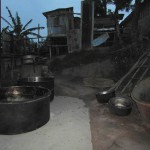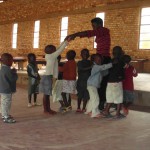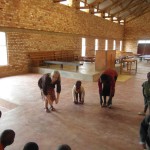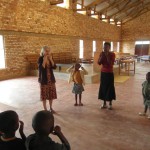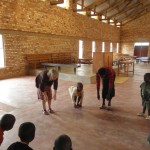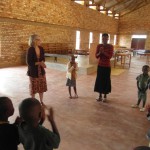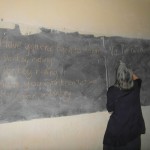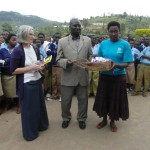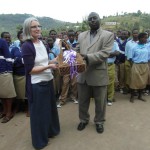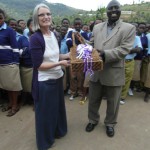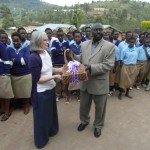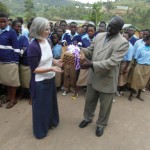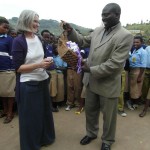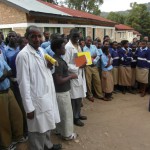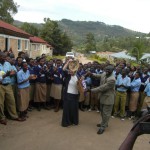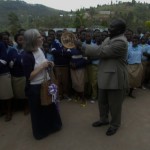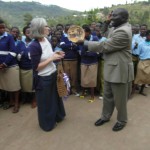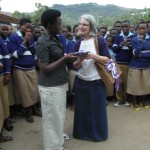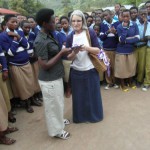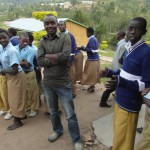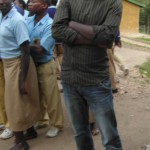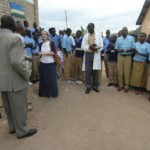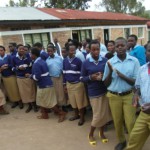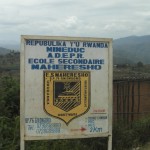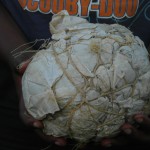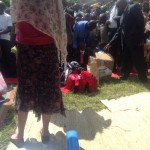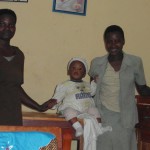TEACHING AND EDUCATIONAL SUPPORT MAHERESHO SECONDARY SCHOOL
One teacher was based at Maheresho Secondary School where she was tasked with assisting with classroom teaching, methodology and assessing educational needs. During her visit, she provided teaching guidance at the school which has a total of 149 boys and 172 girls with an average class size of 48 pupils and donated educational books and equipment. It is now the policy in Rwanda that every child must have 12 years education.
Gikongoro is a rural area high in the hills in the south of Rwanda. The approach to the school is by a dirt-track road typical of rural Rwanda. The land on which the school is built was originally the site of a church established by a Swiss missionary named Hoffman in 1969. A new church has been constructed on the hillside just a short distance from the school by ADEPR (Association of Pentecostal Churches in Rwanda) .
Maheresho is a private secondary school which was established by ADEPR in 1999. The majority of pupils are boarders but day pupils are also welcome. There are 17 teachers, 7 have bachelor degrees, 2 have Diplomas (A1), and 8 have Certificate (A2).Currently there are 149 boys and 172 girls but the school has had up to 400 students. There is an average of 48 students per class. It is now the policy in Rwanda that every child must have 12 years education. Several state-aided secondary and primary schools have now been established in the region; consequently, numbers of new students attending Marehesho School have fallen. The school currently teaches both Ordinary Level and Advanced Level in Maths, Economics and Geography (MEG) and History, Economics and Geography (HEG). The 12 year programme follows through from Primary to Ordinary Level. At present there is no special support for less academic pupils. However, recognising the needs of the local population the school is considering replacing the current Advanced level programme with vocational courses. Gikongoro does not yet have mains electricity so this is impractical at present.
School Layout
As you enter the school gates, to your left and right are terraces of single storey brick buildings with tin roofs. These consist of 8 classrooms, a library, a computer room, staff room and Directors Office. Facing the gates you see the side of the boys’ dormitory and the discipline keepers’ office. There is an uneven slope which leads to the Refectory. Walking round the building you will find the school kitchen. To the side a very uneven dangerous slope leads to the area where students wash their hands before they have their meals. An open area at the back of the kitchen is used for drying the cooking pots etc. From here, a rough path leads up to a gate between the boys dormitory and staff accommodation. Opposite the boys dormitory there is an”eco” toilet block and separate shower block. The girls’ dormitory is placed furthest from the school entrance and is reached by crossing a makeshift volley ball court. Some distance behind the girls’ dormitory there is an open barn which is used to compost solid toilet waste. There is a second gated area of land which has a small plantation of coffee trees and further grassland.
Classrooms
These are brick built with tin roofs. There are windows to either side but the rooms are still quite dark. Some have clear panels inserted into the tin roof just above the blackboard which help bring in more light. However, it is still not easy to read the blackboard from the back of the class. There is one electric light at the front of the class but this is totally inadequate and the supply of electricity is intermittent. The walls are cement rendered but paintwork has become drab and would benefit from a fresh coat of white paint. There are no ceilings and the noise of heavy rain on the roof interrupts lessons as no- one can hear what is being said. This means teachers having to completely change how and what they can achieve or teach in the lesson. Students sit two to a desk. Desks are attached to benches and have a small storage area where students can keep their exercise books. Classes are laid out so desks face the blackboard in lines.. The only teaching resource is the blackboard which runs the full width of the room. There is very little free space.
Computer room
This is small and currently only 6 computers are set up ready for use. The school has a total of 20 computers but the rest are still in boxes. The school’s electricity is supplied by a 3KV generator which was used as little as possible to save on petrol. There was only electricity for the computer room first thing in the morning. Groups of students have only limited time to learn IT skills. They do not have access to the internet as there is no modem or National infrastructure in place.
Library
The library is a reasonably sized room. There are plenty of bookshelves but most are empty. The reference books were old and not linked directly to the curriculum. Generally the library is not used by students because it is of little use to them. There is a section of English Language Teaching Books otherwise 90% of the books are written in French. Teachers continue to use out of date books to prepare their lessons because this is all they have. There are no listening materials such as CDs or tapes so authentic English can be heard. A CD or cassette player in the library with a variety of educational CDs may encourage students to use the library facility.
Sport
There is a small make-shift volleyball court. The football pitch is at some distance from the school. There is a shortage of both football and volleyballs. Some students do not have sports clothes or suitable shoes.
Toilet and washing facilities
There is a cold water supply. Both girls and boys dormitories have shower blocks which are outside at a distance from the sleeping areas. The girls do not have any plumbed water supply – there is a large water tank in the front of the dormitory. All toilet blocks are of the ‘”hole in the floor “ variety. The boys use an “eco” toilet block. Waste is collected in baskets so liquid can seep away. Every morning these baskets are collected, placed in a wheel barrow and transported to the “compost barn”. Students help with this task. After 6months the waste is used as compost on the land. As with the classrooms, all toilets and shower blocks would benefit from being freshly painted white.
Dormitories
The inside of the dormitories was not seen but looking in from the outside they are very basic and have the same problem regards lack of light and electricity. Furnishing is minimal, rooms are dark and dreary. Students are all aware of the need to have torches. The girls do not have running water.
Refectory
The refectory is a large hall with benches and tables. The same room is used for other activities such as worship or creative activities. Again the lighting is poor. There is an analogue television on which students can watch DVD’s at the weekend. Television reception is not good because of the hilly landscape at Gikongoro.
The Kitchen
Students’ food is cooked in large casseroles over an open wood/charcoal fire. The whole room was blackened with soot. No shelves or cupboards. There is a hatch to the refectory. In front of this bench tables are used to serve the food. Each table in the refectory has a numbered wash bowl which is filled with food. The same bowls are used for all meals. Students complain that they eat the same food all the time and that they do not have vegetables. The staple diet is maize, rice and beans with porridge for breakfast.
Teaching Difficulties
Shortage of Course Books -Students do not have any text books
Teachers follow the National Curriculum but have to research each topic area and find appropriate material. Most books that they use are out of date.
The main teaching method is use of chalk and blackboard. Teachers have to summarise and copy text book information onto the board; explain the information, check understanding and allow time for students to copy the notes into their exercise books. This takes valuable teaching time.
I have asked the staff to supply a list of essential books and to state the minimum number required.
Shortage of other teaching materials
The school does not have any facilities to provide authentic English. There is a need for CD/ DVD players and appropriate educational materials for listening and speaking skills.
Maps : Both geography and subject specific maps are needed. I observed a lesson where an administrative map was used to point out where different types of land existed. The teacher wanted to show land contours but this was the only map available.
No paper or materials for creative work.
Volleyballs and football are needed
Generator – at present a 3KV generator is in use but to save on fuel it is only switched on at essential times. For the school to function will and to have IT equipment and more modern teaching resources in the classrooms there is a need for a larger more efficient generator. The Director suggested a 10KV generator. However, it is noted that the government plans to bring mains electricity to the area in the near future.
Lighting inadequate in all classrooms – white paint on walls would help reflect light and brighten up the classrooms

